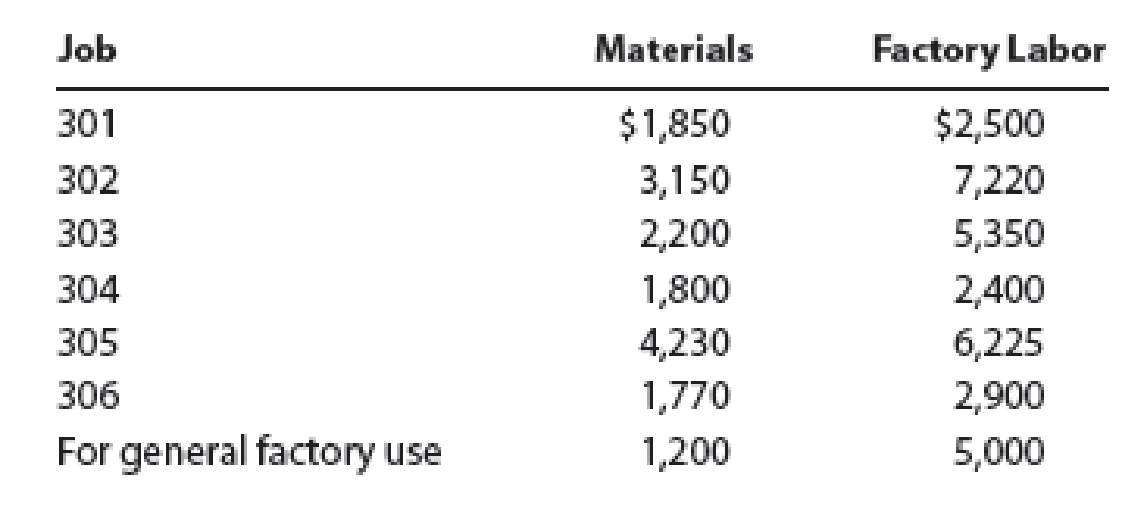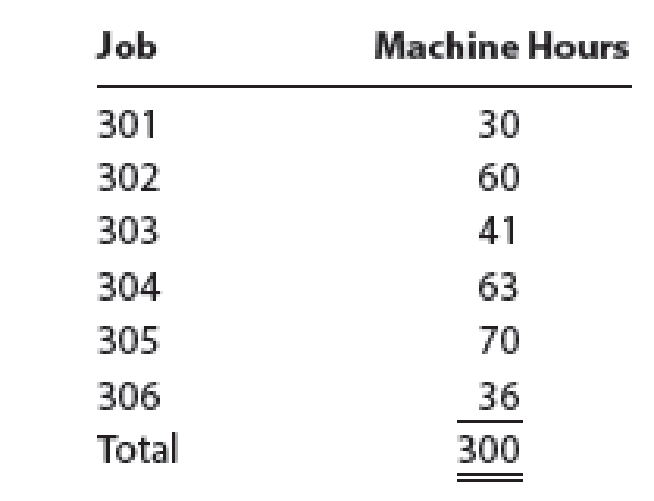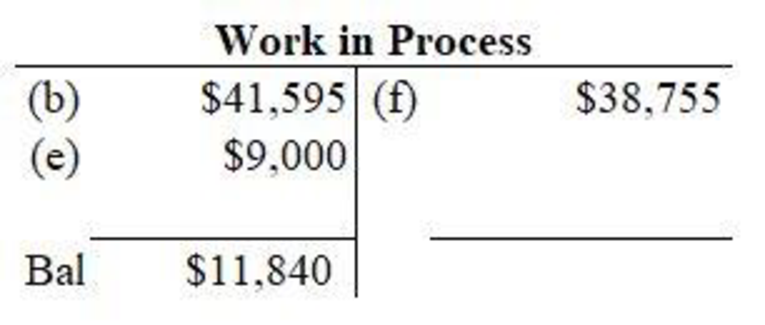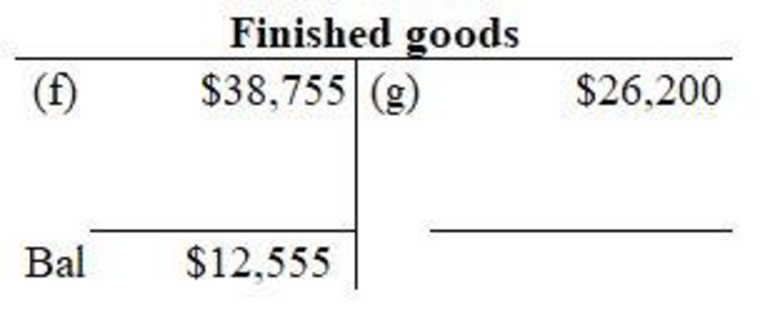
Concept explainers
Entries and schedules for unfinished jobs and completed jobs
Kurtz Fencing Inc. uses a
- A. Materials purchased on account, $45,000.
- B. Materials requisitioned and factory labor used:

- C.
Factory overhead costs incurred on account, $1,800. - D.
Depreciation of machinery and equipment, $2,500. - E. The factory overhead rate is $30 per machine hour. Machine hours used:

- F. Jobs completed: 301, 302, 303, and 305.
- G. Jobs were shipped and customers were billed as follows: Job 301, $8,500; Job 302, $16,150; Job 303, $13,400.
Instructions
- 1.
Journalize the entries to record the summarized operations. - 2.
Post the appropriate entries to T accounts for Work in Process and Finished Goods, using the identifying letters as transaction codes. Insert memo account balances as of the end of the month. - 3. Prepare a schedule of unfinished jobs to support the balance in the work in process account.
- 4. Prepare a schedule of completed jobs on hand to support the balance in the finished goods account.
(1)
Prepare the journal entries to record summarized operations.
Explanation of Solution
Job order costing
Job order cost system provides a separate record of each particular quantity of product that passes through the factory. Each quantity that is manufactured in the business is known as job. Job order costing is used when the products produced are significantly different from each other.
The journal entries of operations of Company KF is as follows:
| Date | Account titles and Explanation | Debit($) | Credit($) |
| a | Materials | 45,000 | |
| Accounts Payable | 45,000 | ||
| (Record materials purchased) | |||
| b | Work in processTable (2) | 15,000 | |
| Factory overhead | 1,200 | ||
| Materials | 16,200 | ||
| (Record material requisitioned to jobs) | |||
| Work in processTable (2) | 26,595 | ||
| Factory overhead | 5,000 | ||
| Wages payable | 31,595 | ||
| (Record factory labor used in production) | |||
| c | Factory overhead | 1,800 | |
| Accounts payable | 1,800 | ||
| (Record factory overhead cost incurred on account) | |||
| d | Factory overhead | 2,500 | |
| Accumulated depreciation – Machinery & Equipment | 2,500 | ||
| (Record depreciation on account) | |||
| e | Work in process | 9,000 | |
| Factory overhead(300 hours × $30) | 9,000 | ||
| (Record overhead applied to jobs) | |||
| f | Finished goodsTable (3) | 38,755 | |
| Work in process | 38,755 | ||
| (Record completion of job) | |||
| g | Accounts Receivable | 38,050 | |
| Sales | 38,050 | ||
| (Record sales on account) | |||
| h | Cost of goods sold Table (4) | 26,200 | |
| Finished goods | 26,200 | ||
| (Record cost of goods sold) |
Table (1)
Justification:
- a) The material is purchased on account. In regard to this, the material account is debited (Increased) and Accounts Payable is a liability and it is credited (Increased).
- b) The materials are requisitioned to jobs which includes direct and indirect cost. In regard to this, Work in process account is debited (Increased), Factory overhead account is debited (Increased), Material account is credited (Decreased), and Wages payable account is credited (Increased).
- c) The factory overhead costs are incurred on account. In regard to this, Factory overhead account is debited (Increased), and Accounts payable account is a liability and is credited (Increased).
- d) Depreciation on machinery is recorded. In regard to this, Factory overhead account is debited (Increased), and Accumulated depreciation – Machinery account is a contra asset and is credited (Increased).
- e) Factory overhead cost is applied to jobs. The work in process account is debited (Increased) and factory overhead account is credited (Decreased).
- f) The jobs are completed in the process. Finished goods account is debited (Increased) and Work in process account is credited (Decreased).
- g) Goods sold on account. Accounts receivable is an asset and is debited (Increased) and Sales affects stockholders’ equity and is credited (Increased).
- h) The cost of goods sold is recorded. Cost of goods sold account is debited (Increased), and finished goods account is credited (Decreased).
Working notes:
The material requisitioned to jobs is calculated as follows:
| Job | Directmaterials | Directlabor |
| 301 | 1,850 | 2,500 |
| 302 | 3,150 | 7,220 |
| 303 | 2,200 | 5,350 |
| 304 | 1,800 | 2,400 |
| 305 | 4,230 | 6,225 |
| 306 | 1,770 | 2,900 |
| 15,000 | 26,595 |
Table (2)
Compute the cost of jobs finished as follows:
| Job | Directmaterials | Directlabor | Factory overhead | Total |
| 301 | 1,850 | 2,500 | 900 | 5,250 |
| 302 | 3,150 | 7,220 | 1,800 | 12,170 |
| 303 | 2,200 | 5,350 | 1,230 | 8,780 |
| 305 | 4,230 | 6,225 | 2,100 | 12,555 |
| 38,755 |
Table (3)
Compute the cost of goods sold as follows:
| Job | Amount ($) |
| 301 | 5,250 |
| 302 | 12,170 |
| 303 | 8,780 |
| 26,200 |
Table (4)
(2)
Prepare the appropriate T-accounts for work in process and finished goods account.
Explanation of Solution
The T-account is prepared as follows:

Figure (1)

Figure (2)
In the work in process account, materials requisitioned for jobs is debited, application of factory overhead to jobs is debited and jobs that are completed are credited. Then, closing balance of work in process is determined.
In finished goods account, Jobs that are completed are debited and sale of goods is credited. Then, closing balance of finished goods is determined.
(3)
Prepare the schedule of unfinished jobs to support the balance in the work in process account.
Explanation of Solution
The schedule of unfinished jobs is prepared as follows:
| Job | Directmaterials ($) | Directlabor ($) | Factory overhead ($) | Total($) |
| No. 304 | 1,800 | 2,400 | 1,890 | 6,090 |
| No. 306 | 1,770 | 2,900 | 1,080 | 5,750 |
| Balance of work in process, Jan 30 | 11,840 |
Table (5)
The unfinished jobs are Job 304 and Job 306. The direct material cost, direct labor cost and factory overhead cost consists of jobs cost. The total of uncompleted jobs constitutes balance of work in process as on January 30.
(4)
Prepare a schedule of completed jobs to support the balance in the work in process account.
Explanation of Solution
The schedule of completed jobs is prepared as follows:
| Job | Directmaterials($) | Directlabor($) | Factory overhead($) | Total($) |
| No. 305 (Finished goods, January 30) | 4,230 | 6,225 | 2,100 | 12,555 |
Table (6)
The completed job is Job 305. The direct material cost, direct labor cost and factory overhead cost consists of jobs cost. The total of completed jobs constitutes balance of finished goods as on January 30.
Want to see more full solutions like this?
Chapter 2 Solutions
Managerial Accounting
- Accounting solutionarrow_forwardI need help with accountingarrow_forwardWhat are two double entries the following transaction? Account Receivable. Account payable. Rent Expenses. Cell phone bill, cable, light bill, gas, and monthly income of $4,000.00 what will be your net income after all expenses are paid. Please figure out your own price for each expense.arrow_forward
- Can you solve this general accounting problem using appropriate accounting principles?arrow_forwardCan you help me solve this general accounting question using the correct accounting procedures?arrow_forwardI need the correct answer to this general accounting problem using the standard accounting approach.arrow_forward
- I need help solving this general accounting question with the proper methodology.arrow_forwardI need the correct answer to this general accounting problem using the standard accounting approach.arrow_forwardI am trying to find the accurate solution to this general accounting problem with the correct explanation.arrow_forward
 Principles of Cost AccountingAccountingISBN:9781305087408Author:Edward J. Vanderbeck, Maria R. MitchellPublisher:Cengage Learning
Principles of Cost AccountingAccountingISBN:9781305087408Author:Edward J. Vanderbeck, Maria R. MitchellPublisher:Cengage Learning Managerial AccountingAccountingISBN:9781337912020Author:Carl Warren, Ph.d. Cma William B. TaylerPublisher:South-Western College Pub
Managerial AccountingAccountingISBN:9781337912020Author:Carl Warren, Ph.d. Cma William B. TaylerPublisher:South-Western College Pub Cornerstones of Cost Management (Cornerstones Ser...AccountingISBN:9781305970663Author:Don R. Hansen, Maryanne M. MowenPublisher:Cengage Learning
Cornerstones of Cost Management (Cornerstones Ser...AccountingISBN:9781305970663Author:Don R. Hansen, Maryanne M. MowenPublisher:Cengage Learning College Accounting, Chapters 1-27AccountingISBN:9781337794756Author:HEINTZ, James A.Publisher:Cengage Learning,Principles of Accounting Volume 2AccountingISBN:9781947172609Author:OpenStaxPublisher:OpenStax College
College Accounting, Chapters 1-27AccountingISBN:9781337794756Author:HEINTZ, James A.Publisher:Cengage Learning,Principles of Accounting Volume 2AccountingISBN:9781947172609Author:OpenStaxPublisher:OpenStax College Managerial Accounting: The Cornerstone of Busines...AccountingISBN:9781337115773Author:Maryanne M. Mowen, Don R. Hansen, Dan L. HeitgerPublisher:Cengage Learning
Managerial Accounting: The Cornerstone of Busines...AccountingISBN:9781337115773Author:Maryanne M. Mowen, Don R. Hansen, Dan L. HeitgerPublisher:Cengage Learning





